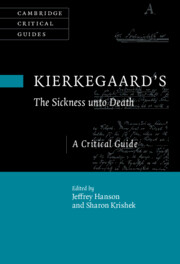Book contents
- Kierkegaard’s The Sickness unto Death
- Cambridge Critical Guides
- Kierkegaard’s The Sickness unto Death
- Copyright page
- Contents
- Contributors
- Acknowledgments
- Abbreviations
- Introduction
- Chapter 1 Kierkegaard’s Place of Rest
- Chapter 2 Publishing The Sickness unto Death
- Chapter 3 Kierkegaard on the Self and the Modern Debate on Selfhood
- Chapter 4 From Here to Eternity
- Chapter 5 Kierkegaard’s Metaphysics of the Self
- Chapter 6 The Experience of Possibility (and of Its Absence)
- Chapter 7 Sin, Despair, and the Self
- Chapter 8 Sin and Virtues
- Chapter 9 Despair as Sin
- Chapter 10 Fastening the End and Knotting the Thread
- Chapter 11 Despair the Disease and Faith the Therapeutic Cure
- Chapter 12 The Long Journey to Oneself
- Chapter 13 Accountability to God in The Sickness unto Death
- Bibliography
- Index
- Cambridge Critical Guides
Introduction
Published online by Cambridge University Press: 26 August 2022
- Kierkegaard’s The Sickness unto Death
- Cambridge Critical Guides
- Kierkegaard’s The Sickness unto Death
- Copyright page
- Contents
- Contributors
- Acknowledgments
- Abbreviations
- Introduction
- Chapter 1 Kierkegaard’s Place of Rest
- Chapter 2 Publishing The Sickness unto Death
- Chapter 3 Kierkegaard on the Self and the Modern Debate on Selfhood
- Chapter 4 From Here to Eternity
- Chapter 5 Kierkegaard’s Metaphysics of the Self
- Chapter 6 The Experience of Possibility (and of Its Absence)
- Chapter 7 Sin, Despair, and the Self
- Chapter 8 Sin and Virtues
- Chapter 9 Despair as Sin
- Chapter 10 Fastening the End and Knotting the Thread
- Chapter 11 Despair the Disease and Faith the Therapeutic Cure
- Chapter 12 The Long Journey to Oneself
- Chapter 13 Accountability to God in The Sickness unto Death
- Bibliography
- Index
- Cambridge Critical Guides
Summary
Søren Aabye Kierkegaard (1813–1855) was a prolific author who published his philosophical writings in various styles and often pseudonymously. In this diverse authorship, The Sickness unto Death stands as something of an exception. Although signed pseudonymously – a method that Kierkegaard often used to put distance between his own view and the one expressed in the text – Kierkegaard regarded this book as highly reflective of his own understanding of the religious life. Rapidly written in the spring of 1848 and published in 1849 after some agonizing, the motivation behind The Sickness unto Death, according to Kierkegaard’s journal, was in part a conscientious conviction that the whole of his authorship needed to be curated in the direction of the religious. The appearance of the second edition of Either/Or in particular provoked him to accompany the reissue with a new and more religiously inflected text. “The second edition of Either/Or really can’t be published without something accompanying it,” he fretted in his journal. “Somehow the emphasis must be on the fact that I’ve made up my mind about being a religious author … If this opportunity passes, virtually everything I’ve written, viewed as a totality, will be dragged down into the aesthetic” (KJN 5, NB10:69/SKS 21, 293–294).
- Type
- Chapter
- Information
- Kierkegaard's The Sickness Unto DeathA Critical Guide, pp. 1 - 5Publisher: Cambridge University PressPrint publication year: 2022



